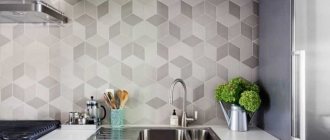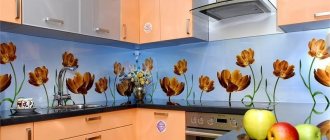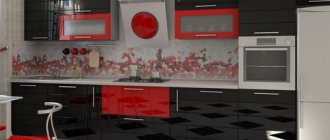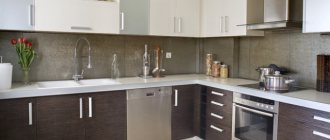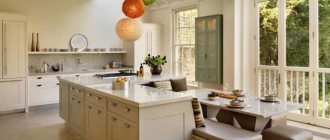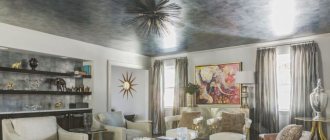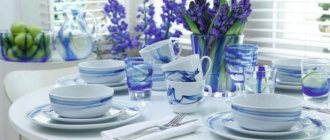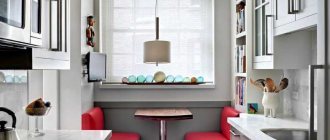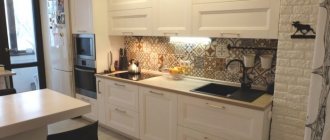Durability and endurance
If you decide to buy a glass apron for your kitchen, this is an excellent investment in the future, because you will save a decent amount of money on repairs and redecoration of the kitchen area. Your apron is more likely to go out of style than to physically wear out. Although designers say that aprons will be relevant for many years to come.
Catalogs of glass aprons can be found in specialized stores, on the manufacturers' website, or directly from the company that will install it in your home.
That is, you can choose from an unlimited number of options, based only on your preferences and financial situation. From most companies you can order large aprons, non-standard shapes with a unique pattern.
Features of each material
Stalinite - quite common, is silicate glass, processed like regular glass, tempered at high temperatures. In fact, it turns out to be several times stronger and denser than ceramic tiles.
To damage stalinite, you need to make a lot of effort. But when split, it will crumble into small pieces with rounded edges, therefore it is considered very safe. It also tolerates high temperatures and sudden changes; with constant heating near the stove, it does not lose its appearance and physical properties.
The downside of the material is that it cannot be drilled or pierced; all shapes are made before hardening. And after it it is dangerous due to a complete split of the panel. Usually masters warn about this, so no one has any difficulties in the future.
Triplex
Triplex is a type of three-layer glass. It is also called laminated because it consists of two layers of glass and a printed layer between them. The optimal glass thickness is 6 mm.
But often the manufacturer does not use stalinite, but ordinary silicate glass. The advantage is that even with a strong impact, the glass will not crumble, but will remain attached to the layer of film that is glued in the middle.
The versatility and simplicity of HDF for an apron
If you are not yet familiar with material such as HDF, let's take a look at its capabilities. What is this innovation? In fact, HDF and MDF are two “brothers” that differ only in their strength and thickness. HDF is made from pressed wood, but technology allows this material to be made thinner and more durable. If MDF has a thickness of 6 mm, then HDF will retain its strength at a thickness of 3 millimeters. Therefore, this material is chosen for the manufacture of kitchen panels.
Photo printing is applied to decorated slabs, which are first pressed, given their shape, and then covered with several layers of varnish, an image is applied and again treated with colorless varnish. Let's look at the photo below to see what HDF panels look like in the interiors of different kitchens.
What is the main advantage of such material? In its cost, which can be compared with MDF. If glass is not a cheap pleasure, then kitchen aprons made of HDF will be affordable for almost everyone. The drawing applied to the surface is not inferior in quality and richness to the picture that “lives” on the plastic. Due to the additional varnish coating, the image will “survive” cleaning, mechanical damage, and high humidity.
Selection of texture and pattern
If finances are critically limited, it makes sense to pay attention to glass substitutes - acrylic and plexiglass. This is a very budget option for a kitchen apron, which is chosen by hundreds of people. Among the advantages is that you can drill and cut after installation. At the same time, a perfectly flat surface is not needed, as for glass.
But the main disadvantage is that the appearance is lost quite quickly; in a few years it will require dismantling and replacement. The coating is short-lived and cheap in appearance. Also, do not install close to hobs, ovens, or heating appliances. In this case, even ceramic tiles are a more profitable investment in your interior.
If you have the opportunity to order a glass apron with photo printing for your kitchen, then it is better not to save money by wasting time on constant repairs.
Successful design solutions
On average, a kitchen apron lasts 5-7 years, so when choosing an image you should take into account that this picture will “please” the eye for quite a long time.
Therefore, you should not choose too bright or expressive images. It is advisable to choose a color scheme that matches the wallpaper or typeface.
If the furniture is made “like wood” or with accents on other natural materials (marble), you need to adhere to the same motives in the design of the apron.
For discreet interiors, you can use plain options.
A photo apron is an excellent solution for decorating a work area in the kitchen, however, before ordering such a product you need to think carefully about all the details, take into account all the pros and cons of each material and choose the most suitable design.
The beauty of this product largely depends on the quality of installation, on how accurately the holes for sockets and other communications are cut (if they are needed on the working wall), so measurements and installation should be entrusted to representatives of the manufacturer.
Types of apron
Plain aprons usually fit into any colorful interior, giving it calm and regularity. If the style of the kitchen is in contrasting, not sharp tones, then a plain canvas will also fit best. You can find a photo of a glass apron that you like directly on the Internet or look at it from famous designers, creating your own interpretation.
A white glass apron is always a good solution; it adds freshness, cleanliness to the kitchen area, and visually increases the space. After its installation, minimal maintenance will be required, since it is easy to spot a stain on white, and it will be easy to wipe it off. Therefore, maintaining cleanliness will not take you much time and effort.
In addition to white, you can choose shades of blue, beige, and gray. Most designers call these colors basic, universal and give them preference, visually zoning the space.
By choosing the right coating, even the smallest simple kitchen can be presented as art.
Subject of the image
Most often, the determining factor when choosing a skin is the decorative design. There are several of the most popular options for decorating kitchen aprons.
- Single-color panels are elegant and presentable. The lack of spectacular images is successfully offset by the versatility and nobility of such products.
- Gradient color transitions look very impressive and allow you to combine contrasting tiers of sets into a single composition.
- Ornaments, patterns, abstractions - discreet cyclical patterns - the optimal design for a kitchen apron. Ornaments allow you to create a spectacular accent and attract attention. At the same time, they perfectly mask greasy splashes and other contaminants. Abstractions fit optimally into any modern interior and also distract attention from existing dirt.
Use geometric shapes if you want to adjust the shape of the room. Horizontal stripes can visually lengthen the wall, while vertical stripes can raise the ceiling.
- Natural motifs are the most popular technique in decorating a kitchen apron. Depending on the owner’s preferences, an image of a forest at different times of the year, exotic jungle, sea with foamy waves, desert, sky, bushes and flowers can be chosen. A wonderful alternative to popular photographs can be a reproduction of a landscape by your favorite artist or a work of photographic art. The ideal frame for such rooms is plain, light-colored walls and furniture.
- Representatives of the animal world. Among the most popular images are kittens, puppies, tigers, dolphins, and birds. Don't forget about the representatives of the insect kingdom. Charming ladybugs, bees and dragonflies are an excellent decoration option.
- Classic images for the kitchen - a variety of products - berries, vegetables, fruits, grains and coffee poured into cups, delicious pastries.
- Cityscapes - photos with a night or snow-covered metropolis are more suitable for a living room or bedroom. For the kitchen, views of cute European streets with cozy cafes are more suitable. Photos with drawbridges look good.
Mirror aprons
A separate category is mirrored aprons. Some housewives are delighted with this idea, others are completely unprepared for such a decision and say that this is the worst of aprons. In fact, a glass panel will significantly expand the space of a small kitchen, adding lightness, airiness, and a fresh look at style.
The visualization will be such that the kitchen will double in size, since the panel will reflect the opposite wall. But there will be twice as much pollution. And some people are not comfortable doing something, constantly noticing their reflection in their peripheral vision.
A glass kitchen splashback with a mirror effect creates a feeling of constant movement and the presence of a large number of people with you in the kitchen. Not everyone is ready for this and over time they will want to get rid of the mirror. But this is a purely individual choice.
Photo selection of beautiful examples and interesting solutions
In a small kitchen, skins with alternating patterns will look good. For large rooms, a plain finishing material or a surface depicting natural motifs is suitable.
Which skins are best for the kitchen ? Real photo examples, which are presented below in a large selection, will help you make the right choice.
0
Features of care
The main advantage of a kitchen with a glass apron is that it is not picky in maintenance.
Installing a glass splashback can take several hours for experienced craftsmen. But then in this kitchen you will need to cook and care for surfaces. If you constantly wipe away emerging grease and dirt, then there will be no problems with cleaning.
If some stains are stubborn, it is better to use non-aggressive chemicals for glass surfaces or induction cookers. In general, the glass coating is resistant to external damage and friction, but you should not be too zealous - you can cause irreparable scratches.
Skin design
Glass base
The special strength of the decorative element is ensured by a high-quality base, which is highly tempered glass. Its strength is five times higher than that of conventional window glass. Being a heavy material, plain glass can crack under its own weight. This does not threaten the components.
The basis of the skin is high-tempered glass
Tempered glass is an expensive raw material. Sometimes in decor they try to replace it with more affordable plexiglass or plastic. The disadvantage of such kitchen skins will be their weak aesthetic expression, since not every type of design can be applied to such materials.
Only a few types of designs can be applied to plastic skins.
The plastic base reacts poorly to temperature fluctuations and ultraviolet radiation, which can cause its deformation and fading of the design, although with careful use, plastic versions of the skinali can last in the kitchen for a dozen, or even more, years.
Temperature changes can cause plastic deformation
For comparison, the service life of glass splashbacks is unlimited.
Drawing
“With the help of stereo printing, glass-based drawings for kitchen skins get a 3D effect”
Images can be applied to kitchen skins in a variety of ways. Popular:
1. Photo printing.
Kitchen skins with photo printing
2. Stereo printing.
Volumetric skinali for the kitchen with stereo printing
3. Film coating.
Covering with film on kitchen skins
The silk-screen printing method is used somewhat less frequently, and laser engraving of skinals for the kitchen generally falls into the category of exceptions.
Photo printing.
The method creates the illusion of three-dimensionality of the image. Compositions recreated in this way allow you to radically change the perception of the surrounding space, they make it so deep and expressive. The main principle for choosing the subject of an image is its harmonization with the color scheme of the interior. It is also important that the scale of the panel adequately correlates with the volume of the kitchen, unless, of course, the designer’s imagination has provided for a different interpretation of the appearance of unusual decor.
Skins with photo printing create a three-dimensional effect
Stereo printing. With its help, drawings on a glass base for kitchen skins get a 3D effect. Special ink is used for this work. Printing of paintings is not limited in subject matter. You can get any image you want, and it will be in excellent resolution and high quality.
Skins for the kitchen with a 3D effect
Film. You can also apply a design to glass by gluing a beautiful film. Its texture can be plain, matte, transparent, covered with drawings and patterns, including three-dimensional, 3D-style, and embossed. The technology of decorating glass with film significantly reduces the cost of producing skinals, which makes the decorative material even more affordable and popular.
Skinali with a film pattern
The use of high-quality film and the fact that the apron adheres tightly to the wall eliminates the possibility of it peeling off when exposed to steam. Such skinals, created to decorate the kitchen, are not in danger of discoloration of the design.
